The American Bullfrogs, also known as common Bullfrogs are a large breed of true frogs that are native to the eastern part of North America. The frogs get their name from the sound that males call during the breeding season, which resembles bull bellowing. The frogs are considered a cuisine in the Southern United States where they are abundant. But are American Bullfrogs good pets? Let’s find out:

Table of Contents
Everything About American Bullfrogs:
In a Glimpse:
| Common Name | American Bullfrogs |
| Scientific Name | Lithobates catesbeianus |
| Other Names | Common Bullfrogs |
| Maximum Length | 8 inches |
| Maximum Weight | 500-800 grams |
| Ranges | North America |
| Habitat | Warm and Moist Environment with Water Source |
| Diet | Carnivore |
| IUCN Status | Least Concern |
| Lifespan | 7-9 years |
Geographic Range:
The frogs are native to the eastern part of the United States and Canada. They are found from Nova Scotia (Canada) to central Florida (USA) across the Great Plains to the Rockies. The natural geographical range of the bullfrogs is unknown because in the early 1900’s the species was introduced in California and Mexico. Later on, the species was introduced to other continents such as Europe, South America, Asia (China, Japan, and South East Asia), etc.
Are Bullfrogs invasive species?
Yes, Bullfrogs have proved to be an invasive species in Asia, especially South-East Asia, Europe, and South America. Their voracious appetite and the large amount of eggs they produce affect the ecological balance negatively. The Bullfrogs often consume other smaller amphibians and native species. Due to their skittish nature, bullfrogs are very difficult to catch when established in a region.
Habitat:
American Bullfrogs are often found near water sources like streams, ponds, lakes, or rivers. However, they are also present in manmade ponds or lakes. Increased water temperature and aquatic vegetation also favour the growth of the bullfrog population.
Physical Description: How do you identify an American Bullfrog?
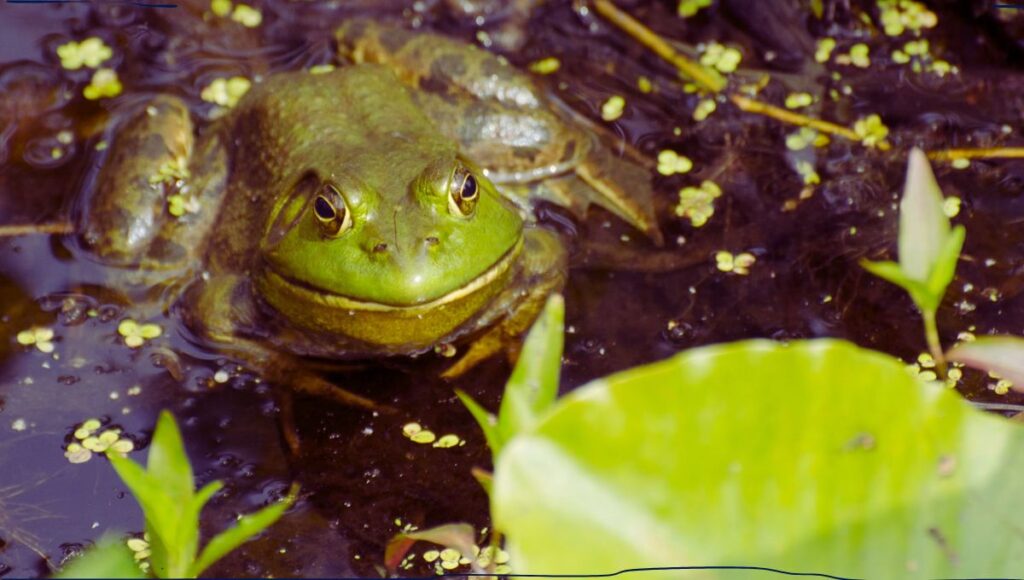
American Bullfrogs are one of the largest frogs in the world and the largest true frog found in North America. The females are larger compared to the males. The bullfrogs’ snout–to–vent length is 3.6 to 6 inches (9 to 15 cm) and sometimes reaches up to 8 inches or 20 cm. The frogs typically weigh between 5 and 175 grams (0.18 to 6.17 oz). A large and mature frog can weigh up to 500-800 grams (1.1-1.8 lbs).
The upper surface of the bullfrog has an olive-green basal colour with either plain or mottling and banding of greyish brown. The hind legs are fully webbed and teeth are tiny and useful for grasping.
The sex can be determined by watching their tympanum or eardrums. The tympanum is circular and located on the side of the head near the eye and in males, the tympanum is much larger than the eye, and in females, it is similar in size. During breeding season the throat of the male bullfrog is yellow whereas in females, it is white.
Is the American Bullfrog poisonous?
Yes, the bullfrogs are poisonous. As a part of their defence mechanism, the bullfrogs secrete poison from the parotid glands behind their ears. Touching the frogs, won’t harm humans but consuming a mature bullfrog can kill small to medium-sized dogs or cats.
Diet:
American Bullfrogs are carnivorous predators. They usually consume small snakes, insects, crustaceans, frogs, tadpoles, and aquatic eggs of fish, frogs, insects, and worms. The bullfrogs are invasive as well as cannibalistic by nature. The frogs don’t even hesitate to consume their kids.
Predators and Threats:
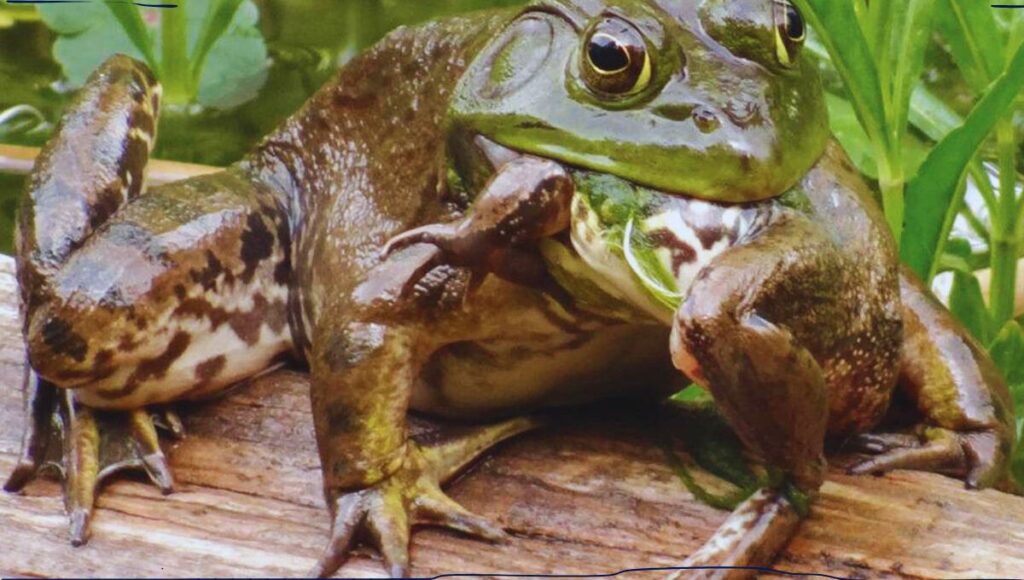
American Bullfrogs have many natural predators depending on the region. Their main predators are herons, turtles, water snakes, raccoons, American alligators, Otters, and prey birds (such as belted kingfishers).
However, many fish and salamanders show high-level dissatisfaction with consuming bullfrog eggs and tadpoles due to their unpleasant taste. In the Southern United States, humans also hunt these frogs due to their delicious meat and legs.
American Bullfrogs are facing many anthropogenic challenges due to the expansion of agriculture, human settlements, the destruction of water bodies, and the development of roads. Despite these challenges, Bullfrogs managed to maintain their population in a secure status (according to NatureServe).
Conservation Status:
American Bullfrogs are listed as Least Concerned in the IUCN Red List of Threatened Species as the population of the frogs is increasing day by day.
Disease:
The Bullfrogs are carriers of chytrid fungus, which causes chytridiomycosis, a fatal skin disease to the frogs and other amphibians. Chytridiomycosis disease is the reason for the declining population of many frog species around the world. One of the famous examples is the decline of Mountain Chicken frogs found in Central and South America (especially in the Caribbean Islands).
Lifespan:
The bullfrogs have a lifespan of 7-9 years in the wild. But in captivity, the frogs can live up to 16 years.
Behaviour:
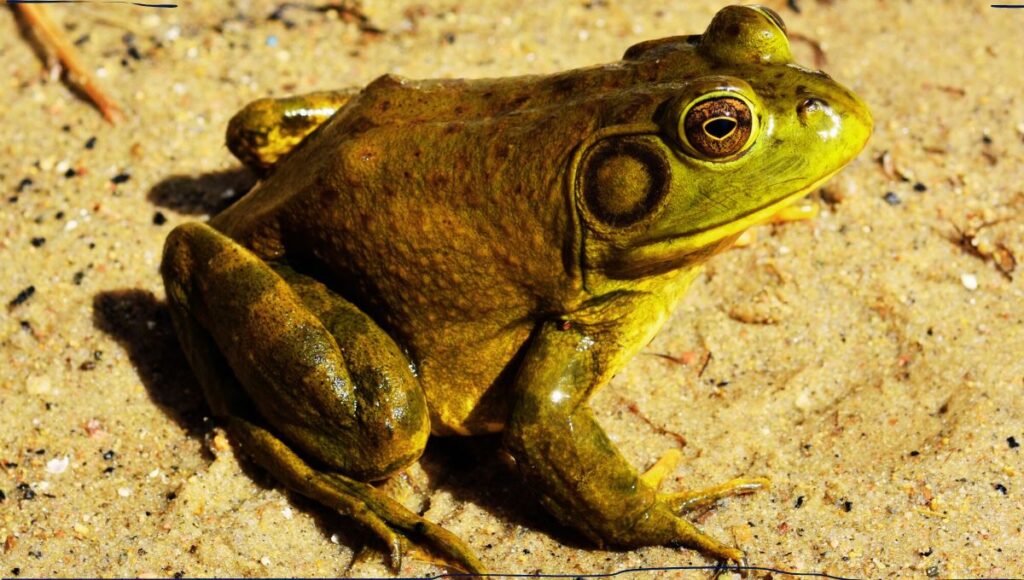
American Bullfrogs prefer warm and moist weather and often hibernate during cold weather in a small cave-like structure in the mud. The frogs usually bury themselves in mud or sand and can construct cave-like structures for the winter.
The frogs usually hunt by the “sit and wait” technique. They are very patient in waiting for food and once the food is within their reach, the bullfrogs grab it with a flash of their tongue.
The Bullfrogs are diurnal, which means they are active day and night. However, they are most active in warm but moist weather. The male bullfrog often shows aggression usually through visual displays and postures to defend their territories. However, sometimes the male frogs wrestle with other frogs to defend their territory. Their territory ranges from 3 to 25 meters of shoreline.
Jump:
Their strong back legs allow them to jump higher and swim perfectly in the water. The bullfrogs can jump 2-3 feet (60-90 cm) on the ground which is four to six times their length.
Communication:
The call of a male bullfrog can be heard over a 1 km area and the sound is often known as low rumbling “jug-o-rum” calling. They also possess a good sense of vibrations and visions.
Ecological Importance:
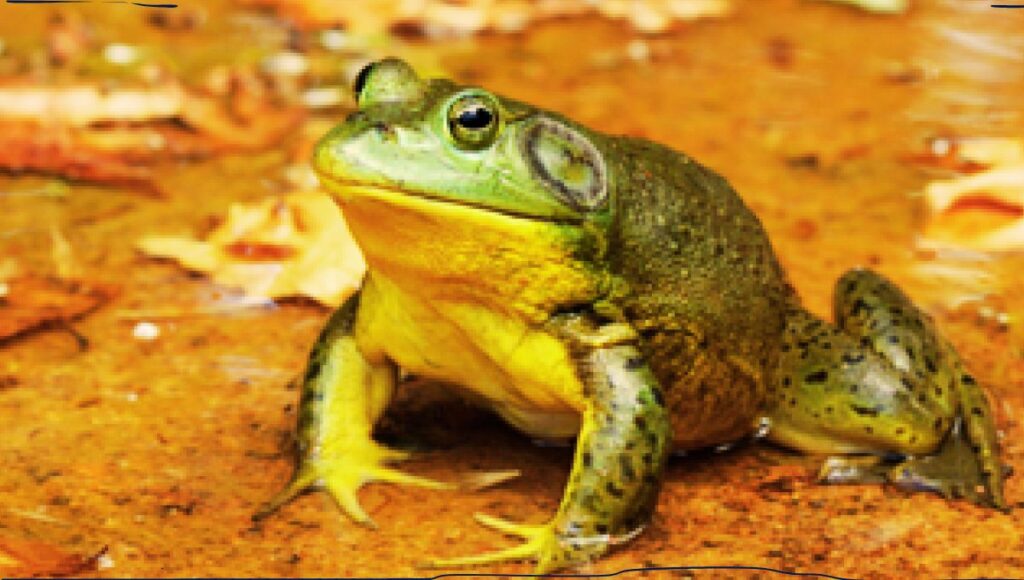
American Bullfrogs are often criticized for their invasive character but the bullfrogs have some positive ecological importance as well. The frogs help in insects and pest control by consuming them. As the number of bullfrogs is increasing day by day, they are often used for medical research because their skeletal, muscle, digestive, and nervous systems are similar to other amphibians and animals that are rare or endangered.
However, the negative impacts of bullfrogs are much greater than their positive impacts. Bullfrogs are treated as invasive species in Southeast Asia, Europe, and South America where they were introduced in the 1900s. The frogs not only harm other native species of that region but also consume their tadpoles due to their cannibalistic behaviour. Their skittish nature makes them very difficult to catch. It is very easy for them to introduce and establish in any region due to their ability to survive and adaptability.
Are American Bullfrogs good pets? Is it banned to have Bullfrogs as Pets?
American Bullfrogs are not suitable candidates for pets because they are large, aggressive, cannibalistic, and invasive species. They require a humid environment with an aquatic area or a large source of water nearby to thrive. The bullfrogs also require a large and steady number of live prey to survive because these frogs are predators.
The bullfrogs are not suitable for beginners because they need extremely careful handling otherwise they might harm themselves or you. The frogs are also poisonous, however, touching them won’t harm you but it is advised to wash hands before and after touching bullfrogs. During the breeding season, the frogs become aggressive (especially males) and create annoying sounds that may not be pleasant for family members.
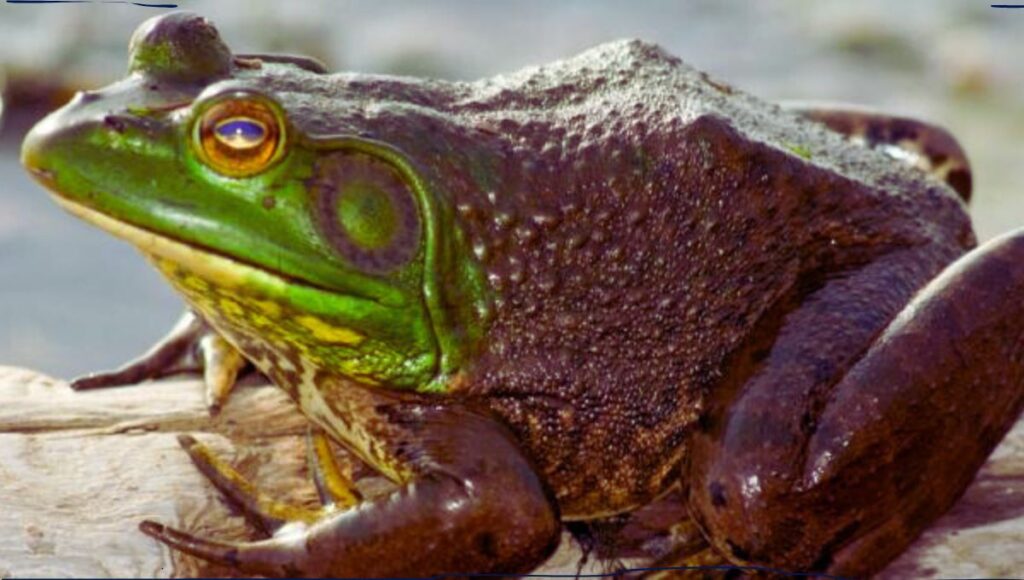
Additionally, the Bullfrogs are invasive species due to their voracious appetite and the large number of eggs they produce, and it affects the local ecosystem negatively. They not only create other native species of the local ecosystem but also spread chytrid fungus, which causes deadly skin diseases for other amphibians. Thus, many countries have banned American Bullfrogs as pets.
Countries such as England, South Korea, Japan, Peru, and Spain completely banned bullfrogs as pets. However, in countries such as Canada, New Zealand, Brazil, Colombia, Chile, Mexico, Argentina, Australia, Haiti, Jamaica, and Puerto Rico, the frogs are considered an invasive species and thus these countries also prohibit or restrict the importation, breeding, and sale of bullfrogs.
In California, Oregon, Washington, and most European Countries, the laws regarding bullfrogs are very strict as they harm the local wildlife ecosystem. Some of them prohibited Bullfrogs and in some of the regions you need a special permit to pet bullfrogs.
How do you buy a Bullfrog?
The sale of bullfrogs is very restricted around the world. However, in some countries and regions, you can have bullfrogs as pets with a special permit. In that case, it is advised to buy the frogs from a reputed breeder and avoid buying the frogs from illegal pet markets. Ask for proof of origin and health certificate before buying the frogs as these frogs often suffer fungal diseases. You can also buy the frogs online, however, check the reviews, policies, regulations, and laws about bullfrogs in your country. The price of American Bullfrog can vary depending on the region but it is expected that its price can start from $15 and can be as high as $50.
Requirements and Care:

Enclosure:
The American Bullfrogs are large and active frogs and the adults require at least 48” L x 18” W x 21” H, or 75 gallons tank for survival. However, the bigger the tank, the better for the frogs. Avoid keeping two bullfrogs in the same enclosure because the species is naturally solitary, and fights for territorial dominance. The frogs are also cannibalistic by nature and hence avoid keeping the bullfrogs with the same species or other amphibian species.
Substrate:
The bullfrogs require a thick layer of moisture-holding substrate to cushion their bodies and maintain the required humidity level. For the land portion, you can use coco fibre, which is made from coconut husks, as a substrate because these are good at holding moisture and are easy to clean. For the water portion, you don’t need any substrate but if you plan to plant live plants then you require substrates such as fluorite or riverbed sand to support plant growth.
Temperature and Humidity:
The bullfrogs need a warm and humid environment to survive. The warm part of the tank should be fixed at 80-84 degrees temperature and on the cooler side the temperature must be 70-74 degrees Fahrenheit. You can use thermometers to check the temperature of the enclosure and also use a heat mat and heat lamp to increase the temperature of the tank, but avoid overheating it.
The bullfrogs need 60-70% humidity at least to survive. You can use a hygrometer to check the humidity level. A fogger or mist humidifier can help you to control the humidity level. Otherwise, you can sprinkle water several times a day to maintain the humidity.
Light:
The American Bullfrogs require 12 hours of light circle to regulate their daily activities. You can use a UVB bulb or a low-wattage fluorescent, LED bulb to provide them sufficient light. UVB bulb provides them with all of the vitamin D that their body needs stimulates better appetite and activity, and makes them healthy.
Decor:
Only land and water in the enclosure can be very boring to the Bullfrogs. They at least need something to interact with in the enclosure, doesn’t matter how big the enclosure is. You can use mopani wood, cork bark, live or artificial plants, artificial caves, and rocks to entertain the frogs. However, avoid pebbles because the bullfrogs can swallow them.
Diet:
American Bullfrogs are carnivorous and they eat almost everything that fits in their mouth. The amount of food required depends on their age, sex, health condition, activity level, and appetite. You can feed an adult bullfrog every other day to avoid obesity.
However, the tadpoles are herbivorous and they consume algae and other aquatic plant material. If you have bullfrog tadpoles, you need to feed them every day.
You can give the American Bullfrogs live prey or pre-killed foods such as Black soldier fly larvae, Crawdads, Earthworms, Fish, Hornworms, Mealworms, Mice, Shrimp, Silkworms, Snails, etc but coat and dust the food with calcium and vitamin supplements.
Handling:
The Bullfrogs don’t like to be handled by humans. If you want to create a bond with the frog you need to feed it with soft-tipped feeding tongs rather than using your fingers as the bullfrogs have very powerful bites. Don’t touch your frog unless it is very necessary, otherwise, it might create stress for the frog. Wear a pair of nitrile gloves before touching and gently grasping the frog behind the head with one hand and with the other hand restrain the rear legs.
Cleaning:
The enclosure must be cleaned daily to remove waste food, dead insects, and mouldy substances to prevent bacterial growth. Also, deep-clean the entire tank with dechlorinated water and mild disinfectant once a month. The substrate should be changed every three months to prevent bad smells.
With proper care and attention, American Bullfrogs can live up to 16 years in captivity.
11 Differences Between American Bullfrogs and African Bullfrogs:
However, there are many similarities between American Bullfrogs and African Bullfrogs but there are also a lot of differences between them. Here are the top 11 differences between American Bullfrogs and African Bullfrogs below:
| Serial No. | Criteria | American Bullfrog | African Bullfrog |
| 1 | Geographic Ranger | North America | Central and Southern Parts of African |
| 2 | Habitat | A warm and moist environment with water bodies | Moist to dry savanna, subtropical or tropical shrubland, freshwater lakes, marshes, etc. |
| 3 | Size and Weight | Much smaller, 500-800 grams maximum weight. | Twice the size of the American Bullfrog. |
| 4 | Sexual Dimorphism | Males are smaller than females | Females are smaller than Males |
| 5 | Colours | Olive-green basal colour | Olive green with yellow/orange shades in the throat. |
| 6 | Poisonous | Yes | No |
| 7 | Bite Force | They can bite but the bite force is smaller than African Bullfrogs | Much larger bite force than the American Bullfrogs |
| 8 | Lifespan | 7-9 years in the wild | 20-25 years in the wild |
| 9 | Teeth | Only in the upper jaw | Both the upper and lower jaw have teeth |
| 10 | Enclosure | Minimum size of tank: 75 gallons | Minimum size of Tank: 10 gallons |
| 11 | Population | Abundant in North America | However, they are listed as “Least Concern” but Considered “Near Threatened” in South Africa due to habitat loss. |
Also Read: Are Pixie Frogs (African Bullfrogs) Good Pets? Everything You Should Know Before Purchasing